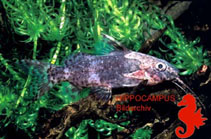| Family: |
Mochokidae (Squeakers or upside-down catfishes), subfamily: Mochokinae |
| Max. size: |
25.8 cm SL (male/unsexed) |
| Environment: |
benthopelagic; freshwater; pH range: 6 - 7.5; dH range: 25, |
| Distribution: |
Africa: coastal drainages of the Bay of Guinea from Ghana to Gabon (Ref. 82238), including the Pra, Sio, Mono, Niger delta, Kwa Ibo (Ref. 57223), Cross (Ref. 57223, 81251), Wouri, Sanaga (Ref. 81251, 82238), Mungo (Ref. 81251), Lobe and Kribi (Ref. 82238). Possibly also in the Nyong (Ref. 81251). Presence in Volta and Comoe basins (Ref. 82238) unconfirmed (Ref. 57223). Presence in Gabon (Ogooue drainage) questionable (Ref. 78218) and unconfirmed (Ref. 81251). |
| Diagnosis: |
Dorsal spines (total): 1; Anal spines: -0. Diagnosis: gill slits not extending ventrally beyond pectoral-fin insertions; interorbital space less than 50% of head width (Ref. 57223), 58.5-86.6% of snout length (Ref. 81251); post-orbital length at least 60% of snout length (Ref. 57223, 81251). Entire margin of opercle smooth (Ref. 81251). Maxillary barbels longer than head, unbranched, without tubercles and bordered by a distinct, black basal membrane (Ref. 57223, 81251), at least as broad as barbel (Ref. 81251). Outer mandibular barbels with rather long, numerous, simple and thin ramifications, branches of inner mandibular barbels long, subdivided/dichotomous and moderately thin (Ref. 57223). Mandibular teeth rather long (Ref. 57223), movable (Ref. 81251), numbering 21-46 (30 in the lectotype)(Ref. 57223, 81251). Denticulations of pectoral-fin spines weaker on outer than on inner margin (Ref. 57223), with twice as many serrations along anterior edge as posterior (Ref. 81251). Dorsal-fin spine smooth anteriorly, prolonged into short filament, as are almost all of the branched dorsal-fin rays (Ref. 57223, 81251). Humeral process twice as long as deep, pointed and granulose, not keeled ventrally (Ref. 57223, 81251). Adipose fin little developed and low, distinctly separated from rayed dorsal fin (Ref. 57223), base of adipose fin 1.5-3.4 times distance between dorsal fin and base of adipose fin (Ref. 81251). Body covered with spots of about 1 mm in diameter; caudal fin spotted (Ref. 57223, 81251), but without single dark patch at base of each fin lobe (Ref. 81251).
Description: snout obtuse; lips not developed; pelvic fin not reaching anal fin; caudal fin deeply forked, with upper lobe slightly longer; caudal peduncle as long as deep (Ref. 81251).
Coloration: rather dark, with numerous small spots on dorsal region (Ref. 57223, 81251), especially in juveniles (Ref. 81251). All fins, including adipose, marked with non-aligned, small, black spots (Ref. 57223, 81251). |
| Biology: |
Its electric organ is located dorsally and consists of modified striated muscle (Ref. 10011). Oviparous (Ref. 205). Maximum TL recorded was 37.5 cm (Ref. 57223), maximum SL (for Lower Guinea only?) 16.8 cm (Ref. 81251). |
| IUCN Red List Status: |
Least Concern (LC); Date assessed: 02 September 2019 Ref. (130435)
|
| Threat to humans: |
harmless |
Source and more info: www.fishbase.org. For personal, classroom, and other internal use only. Not for publication.

